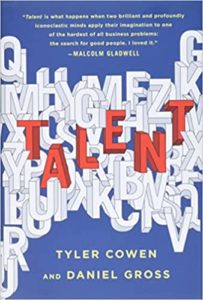The World's Got Talent
By Arnold Kling


- When it comes to talent, we will try to teach you how to think past the bureaucracy.
- We focus on a very specific kind of talent in this book—namely, talent with a creative spark—and that is where the bureaucratic approach is most deadly. In referring to the creative spark, we mean people who generate new ideas, start new institutions, develop new methods for executing on known products, lead intellectual or charitable movements, or inspire others by their very presence, leadership, and charisma, regardless of context.
- —Tyler Cowen and Daniel Gross, Talent: How to Identify Energizers, Creatives, and Winners Around the World (p. 9)1
- In today’s economy, capital may no longer be the primary scarce resource to be allocated.
- … it is easier to understand the economic challenge today as one of allocating talent to solving problems.2
Cowen and Gross (CG) point to the need to be able to find talent in other cultures. In the coming decades, the proportion of young people in the world that come from Africa will be soaring, and those seeking talent will need to be able to find it there.
When we think about the problem of allocating capital, we think of the stock market. The problem of allocating talent has some similarities to the problem of picking stocks, but also some differences.
Success in the stock market comes not from finding the best company, but the most undervalued company. Similarly, CG write,
- … seeing the whole package requires a much deeper synthetic ability, a good deal of luck, and what we are calling entrepreneurial alertness—that is, the ability to spot and perceive talents that others do not see. (88)
In major professional sports, notably baseball, we have seen the phenomenon described in Michael Lewis’s Moneyball. Armed with increasingly sophisticated data, statisticians have become heavily involved in the talent-evaluation process. As of now, a similar approach will not work for identifying the great entrepreneurs, business leaders, or cultural innovators. But CG allude to the possibility that at some point in the future a data-driven approach may become feasible.
For now, the data that we have to work with contain too much noise. Success in the fields that CG are concerned with is not measured as definitively as it is in stock market investing or baseball.
CG see talent as resulting from psychological traits, and this creates another source of noise. Measures of IQ are reliable, in that they replicate well across different testing instruments and across the same individual over time. As a result, IQ tends to work better than other measures as a predictor of success in many realms. But CG write
- The most measured and thoughtful study is by Ken Richardson and Sarah H. Norgate… the researchers’ conclusions are pretty sobering: “In primary studies such correlations [between IQ and job performance] have generally left over 95% of the variance unexplained.”
- So to put it another way, chasing high-IQ hires with few other considerations is not a good way to find talent… smart people—and maybe you are one of them—overrate the importance of smarts. (93)
Yet these “other considerations” are plagued by worse noise. CG discuss the Big Five personality measures that are most respected by academic psychometricians: Openness, Conscientiousness, Extroversion, Agreeableness, and Neuroticism. My impression is that these measures are not so reliable, in that results can vary depending on the survey instrument used, and are also not necessarily stable over one’s lifetime. I also think that they may be highly context-sensitive. Someone might be an introvert in a sports bar and yet be an extrovert at a faculty lunch.
CG note that some of the research on the impact of personality on performance is focused on employees near the average. But the sort of talent they are looking for is at the very top, and they find that studies focused on extreme success sometimes show that different factors matter.
Not surprisingly, given the noise inherent in the process of measuring personality, it is difficult to generalize about how one might use scores on the Big Five in assessing talent or potential. CG conclude,
- … personality theory—in its various guises—is a tool for mobilizing and communicating the dispersed knowledge to be found among your hiring network. … think more in terms of a useful language for your team rather than trying to reflect, replicate, or anticipate the latest academic results. (124)
In organizations it helps to be able to recognize how personality traits vary across individuals, in order to facilitate cooperation and mutual respect. I believe that for that purpose, other personality systems, such as Myers-Briggs, may prove easier to understand and to use, even though they are even less sound statistically than the Big Five.
In any case, I would point out that hiring managers and venture capitalists do not have candidates’ Big Five scores on personality tests to work with. Instead, they form impressions of candidates’ personality traits, gleaned from interviews and, to a lesser extent, reference checks. That introduces yet another important source of noise—the difference between how the interviewer perceives the candidate and how the candidate would score on a formal personality test.
All that said, CG believe that personality matters a great deal, and I agree. They also believe that personality can be assessed on the basis of skilled interviews. I agree with this as well, and their chapter on “How to Interview and Ask Questions” provides food for thought for anyone involved in any organization in any capacity.
CG especially prize people who are dedicated to self-improvement. They want to hear people explain how they go about improving themselves. “What is it you do to practice that is analogous to how a pianist practices scales?” is one of their interview questions.
Some of their favorite questions,
- … ask the respondent to give an account of their own self-awareness. In essence, you are trying to learn how many cultural and intellectual worlds an individual is master of, and how much perspective they have on their own perspectives. That is what we mean by “meta”—that the person is considering their own thought world from a viewpoint one level higher, more general, and more distant. (49)
I would say that this can be applied to conducting interviews. Practice and self-evaluation are important. Why couldn’t I get the candidate to relax and open up? Why did this person turn out to be not a good fit—what did I miss?
When I meet someone new in a social setting, I will often ask many of the same sort of questions I would ask if I were interviewing them for a job. It is analogous to how a pianist practices scales.
I would caution against trying to copy anyone’s hiring approach, as if one style fits all. You have to be very conscious of your own personality and how it affects what you are looking for. CG are deliberately looking for high-variance individuals. Like venture capitalists, they are willing to take a risk in order to have a high upside. That may not be your style, just as investing in start-ups may not be your style.
When I hired employees, I had some tolerance for arrogance, because a really good software engineer can be so much more productive than a run-of-the-mill developer. But other managers will never put up with a prima donna.
For more on these topics, see
Hiring is different in different contexts. I never had a staff of more than a handful of employees, so a lot of the context consisted of dealing with me. Of the two of us in the interview, I was often the quirkier personality. I invited the respondent to ask questions, and the best indicator of fit was the amount of time this reverse question-and-answer session went. A good candidate would be trying to figure me out, deciding whether I was worth taking a chance on.
Whichever side of the interview table you are on, you want to get better at assessing the other person. A good way to improve your ability to identify talent in context is to read Talent.
Footnotes
[1] Tyler Cowen and Daniel Gross, Talent: How to Identify Energizers, Creatives, and Winners Around the World. Nicholas Brealey Publishing, 2022.
[2] Arnold Kling. “From Allocating Capital to Allocating Talent”. ArnoldKling.com, “Arguing in My Spare Time”, No. 12, April 24, 1998
*Arnold Kling has a Ph.D. in economics from the Massachusetts Institute of Technology. He is the author of several books, including Crisis of Abundance: Rethinking How We Pay for Health Care; Invisible Wealth: The Hidden Story of How Markets Work; Unchecked and Unbalanced: How the Discrepancy Between Knowledge and Power Caused the Financial Crisis and Threatens Democracy; and Specialization and Trade: A Re-introduction to Economics. He contributed to EconLog from January 2003 through August 2012.
Read more of what Arnold Kling’s been reading. For more book reviews and articles by Arnold Kling, see the Archive.

